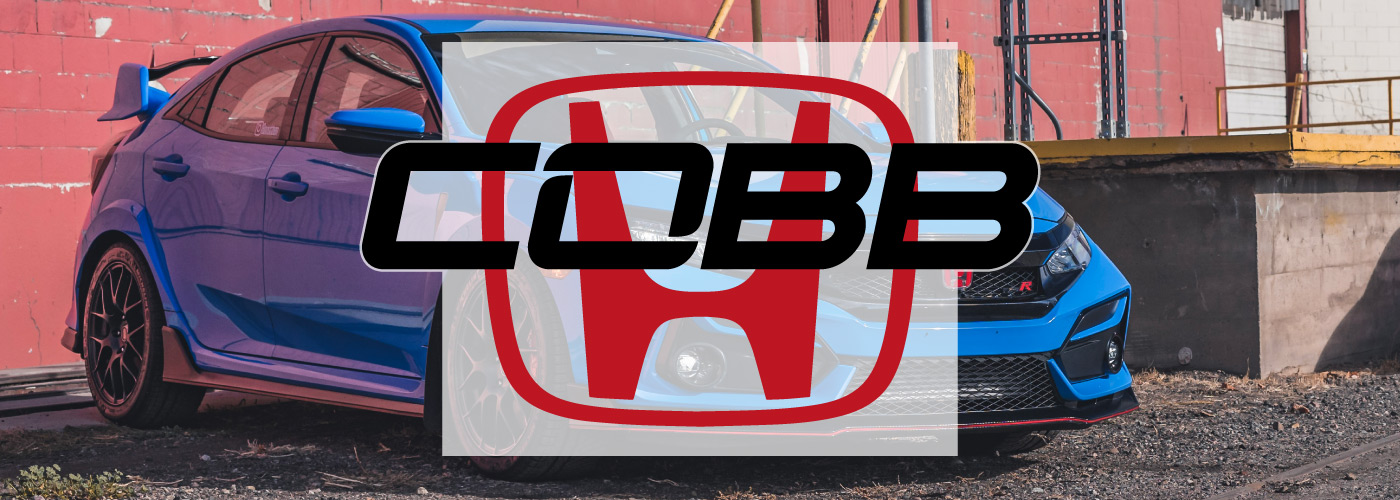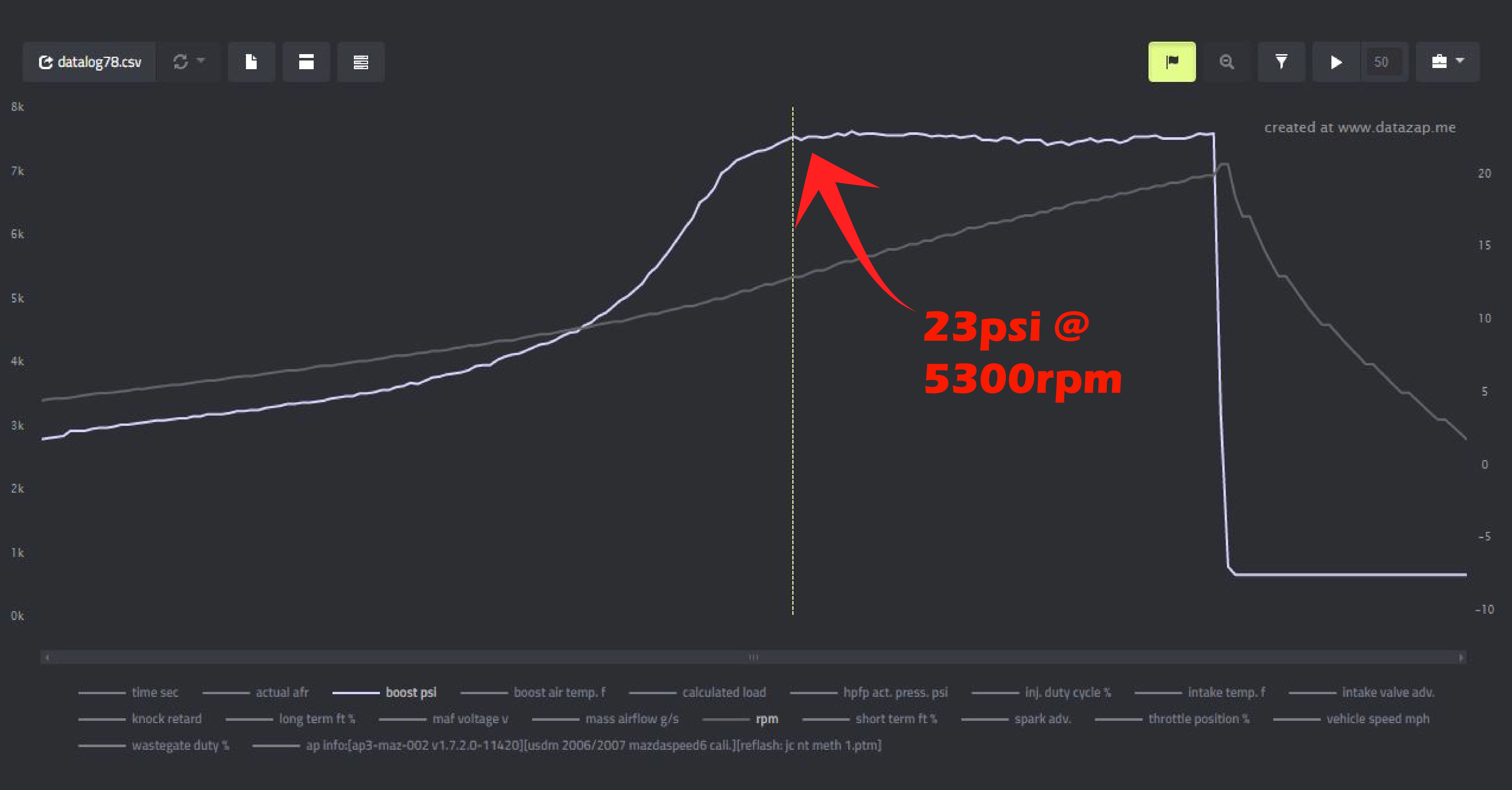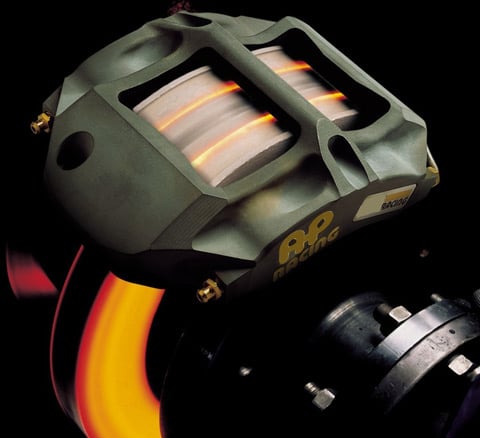
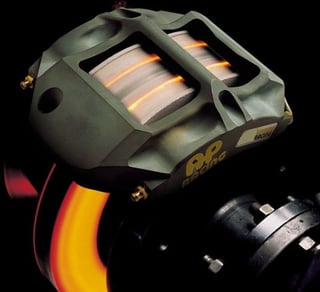 Deciding which brake pads to use can be confusing and frustrating if you’ve never looked into it and don’t have a lot of experience with different setups and how they act and perform. For what seems like a simple part with many similar choices, the truth is actually completely opposite of that theory. Brake pads are not simple and the choices are not all similar. There are a wide range of brake pads for different uses and applications. Because they are much more complicated than it seems on the surface, it is critical not to overlook which brake pads you want or need. We’ve prepared a short guide to help our customers decide which brake pads are right for them and which ones to stay away from based on their intended use.
Deciding which brake pads to use can be confusing and frustrating if you’ve never looked into it and don’t have a lot of experience with different setups and how they act and perform. For what seems like a simple part with many similar choices, the truth is actually completely opposite of that theory. Brake pads are not simple and the choices are not all similar. There are a wide range of brake pads for different uses and applications. Because they are much more complicated than it seems on the surface, it is critical not to overlook which brake pads you want or need. We’ve prepared a short guide to help our customers decide which brake pads are right for them and which ones to stay away from based on their intended use.
The first few questions you need to ask yourself are as follows.
- What kind of car is the brake pad being used on?
- What kind of driving are you doing?
- What is your budget?
The budget question can be answered right away. If you are looking for the absolute cheapest brake pad, a ceramic pad is not the best option. Due to the technology and materials behind a ceramic brake pad, it simply costs more to make and to produce. However, depending on if it’s a good fit for the car, it is typically worth the extra cost. We’ll get more into why you might or might now want a ceramic brake pad setup a little further in.
If you have a truck, SUV, or something hauling heavier loads on a regular basis, or even a heavier vehicle in general, ceramic is typically not a good choice. Ceramic brake pads are not meant for heavy duty use like the semi-metallic brake pads are. Braking performance becomes very important for heavy duty use, almost as much as it does a for high performance race car. This means pad selection is important for heavier duty vehicles too. For the sake of this article, we will stick to high performance cars only.
The type of driving you will be doing is the main factor in choosing the correct brake pad. Like mentioned before, we’ll be focusing on high performance vehicle braking only with this article. We’ll start with a basic understanding of the advantages and disadvantages to each type of brake pad material.
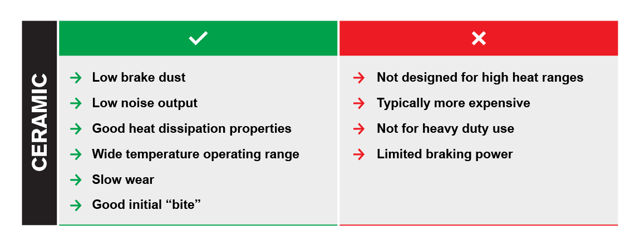 Ceramic brake pads are known to be the best overall pad you can buy for most normal driving circumstances. They have a large range of temperatures that they are still effective in. They offer good wear properties and have low noise and dust which is the main reason why consumers have demanded more ceramics to be put out on the market. Although they are a great overall pad for the street, they do have their limits in the overall peak ability to perform well for longer periods of time in high performance driving situations. If you never see a track, ceramic pads are a great way to increase braking power, reduce dust and noise, and still offer great performance.
Ceramic brake pads are known to be the best overall pad you can buy for most normal driving circumstances. They have a large range of temperatures that they are still effective in. They offer good wear properties and have low noise and dust which is the main reason why consumers have demanded more ceramics to be put out on the market. Although they are a great overall pad for the street, they do have their limits in the overall peak ability to perform well for longer periods of time in high performance driving situations. If you never see a track, ceramic pads are a great way to increase braking power, reduce dust and noise, and still offer great performance.
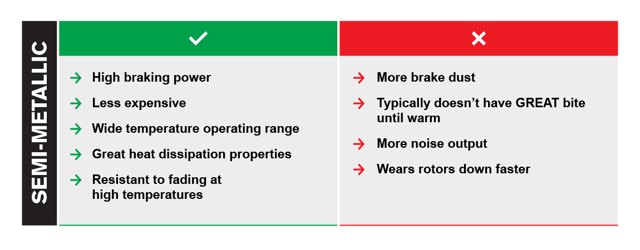
Semi-Metallic brake pads are the go to brake pad for anybody demanding that their brakes take them to the next level of high performance. They don’t have great bite until they’ve been heated up to a certain point but most of them are still fine under normal circumstances, even when somewhat cold. The concept behind a semi-metallic pad is to use materials that will withstand higher temperatures and still continue to “bite” the rotor and maintain a high level of friction. Although this means that more dust is created, more noise can occur, and it eats away at the rotor faster, performance is not compromised. At the end of the day, when you need them to perform having more dust or a faster wearing pad and rotor is what has to be compromised for going faster (or stopping faster).
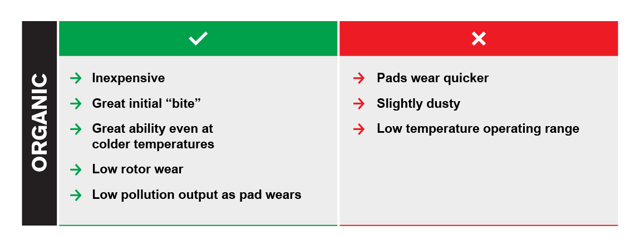
Organic brake pads are known to be the standard pad that any given car will typically come with if high performance is not the most important consideration. They are inexpensive, they have good braking performance under normal circumstances, and they’re a good all around brake pad for daily use. They will get the job done for any car going to work, running errands, getting the family around, and occasionally needing to stomp on the brakes.
After showing you the basic advantages and disadvantages of each type of pad material, now we’ll go into what we recommend you select, based on your intended use. There are a handful of situations that any given enthusiast chooses to participate in. Most people will fall into any one of these categories but if you don’t, choose as close to a similar situation as possible. We’ll also give examples of certain pads you can use that are available through our store.
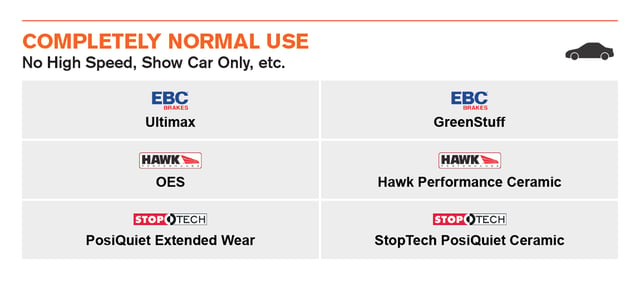
If you are the type that uses your car to run to the grocery store, go out for a casual weekend cruise, or put your car on display and nothing else, organic brake pads or ceramic brake pads are a good choice. Ceramic is a great choice for the cleanliness and low noise but if you don’t car to spend the extra money for better pad characteristics, an organic pad will work just fine.
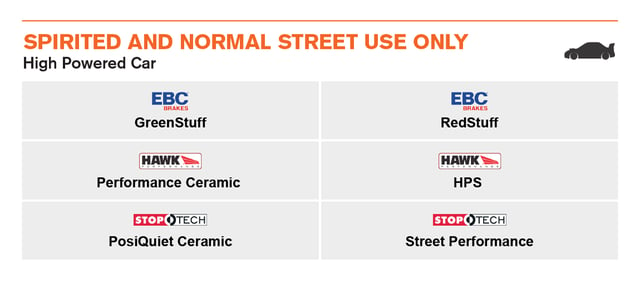
A ceramic brake pad compound is probably best for this scenario. Although we never advise it, going fast is just something you eventually do if you have a fast car (safely, of course). On the street, unpredictable circumstances, for example, 90 year old grandparents in their Cadillac slamming on the brakes or merging negligently, cause quick and unexpected use of your brakes. You need to be able to reel in the car quickly with street use. Meanwhile, ceramic pads still have a good operating range so they can still brake hard after heating them up on a quick deceleration from higher speeds. Meanwhile, they’re nice to your rotors and wear slowly.
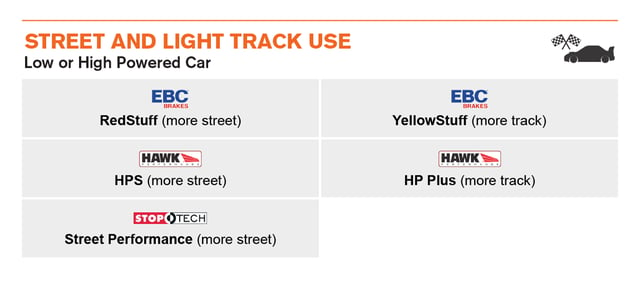
Depending on what type of track use, a performance ceramic pad might still do the trick. If you do quick autocross sessions, a ceramic pad will still provide excellent braking ability and get you home feeling just fine if you need to use the brakes more than normal. If you want to do longer track sessions with higher speed decelerations, you’ll definitely want a semi-metallic brake pad. Even 2-3 laps around a high speed track can develop a significant amount of heat in the pad. Ceramic will eventually reach its limit of providing good friction levels.
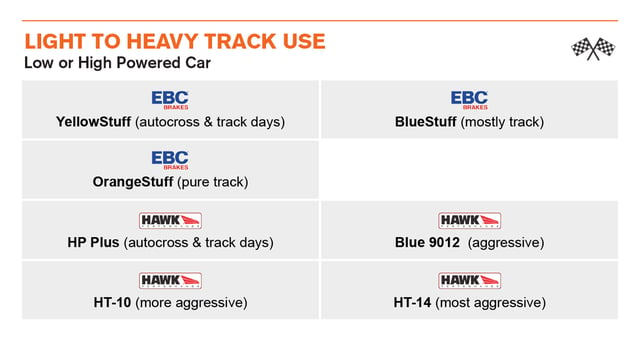
The bottom line is that repeated use of the brakes during high speed scenarios will get your brakes hot and keep them there. You absolutely cannot compromise brake pad ability if this is the situation you are in. Bad brakes will not only compromise how fast you can go around the track but also your safety if they are not able to perform. The last thing you want is to go off the track or run straight into another car on the track because your pads don’t bite. That’s a decision based error on what equipment is on your car. The higher powered and faster the vehicle is, the more important it is to choose an aggressive pad. The amount of friction taking place at high speed makes it necessary to have something that works over and over again.
To shop for your own brake pad application, click on the following links.
All brake pads!
EBC Brake Pads
Hawk Performance Brake Pads
StopTech Brake Pads
HAVE QUESTIONS OR NEED TO GET A HOLD OF US? CALL, EMAIL, OR CHAT WITH US ONLINE!
http://www.edgeautosport.com
PHONE: 303-268-2140
I'm the founder of Edge Autosport and I remember first getting into cars in high school. I read all the magazines, bought a bunch of technical books, and finally got to start wrenching around the age of 19. I really enjoy modding and being able to live out a passion is truly awesome. I wouldn't change a thing.
Topics:
